Athena Review Vol. 5, no. 1
Records of Life: Fossils as Original Sources
9. Jawless Fish (Agnatha)
The earliest fish, dating from the Cambrian and Ordovician periods (541-443 mya), lacked a lower jaw; such jawless fish are grouped in the superclass Agnatha (“no jaw”). Some of the agnathian families survived into the Devonian period (419-359 mya). The first of the jawed fish (gnathostomes) developed in the Silurian period (443-419 mya). Two groups of jawless fish comparable to Paleozoic fossil taxa remain alive today: hagfish and the lamprey.
Lampreys constitute a single order called Petromyzontiformes. The lamprey is considered a primitive marine vertebrate which may be one of the oldest extant groups of fish. Lampreys are an order of
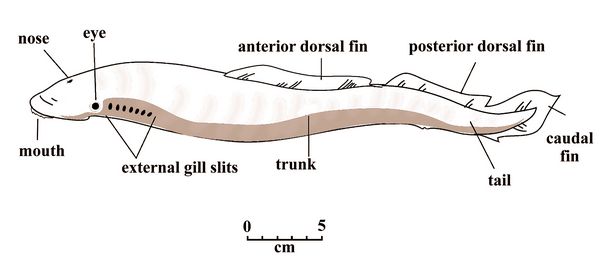 jawless,
eel-like vertebrates, with a cartilagenous skeleton. Taxonomists place
lampreys and hagfish in the subphylum Vertebrata of the phylum
Chordata. Lampreys are not considered to be true fish, but
represent very ancient lineage of vertebrates, possibly the most basal
group of the Vertebrata. The lamprey has been extensively studied
because its relatively simple brain is thought in many respects to
reflect the brain structure of early vertebrate ancestors.
jawless,
eel-like vertebrates, with a cartilagenous skeleton. Taxonomists place
lampreys and hagfish in the subphylum Vertebrata of the phylum
Chordata. Lampreys are not considered to be true fish, but
represent very ancient lineage of vertebrates, possibly the most basal
group of the Vertebrata. The lamprey has been extensively studied
because its relatively simple brain is thought in many respects to
reflect the brain structure of early vertebrate ancestors.Fig.1: External anatomy of Petromyzon, a sea lamprey
Adults are characterized by a toothed, funnel-like sucking mouth. The common name "lamprey" is derived from Latin lampetra ("stone licker" , from lambere "to lick" and petra "stone"), probably from female lampreys who attach themselves to a stone while giving birth. Adults physically resemble eels, in that they have no scales, and can range anywhere from 13 to 100 centimetres (5 to 40 inches) long. Lacking paired fins, adult lampreys have large eyes, one nostril on the top of the head, and seven gill pores on each side of the head. Lampreys live mostly in coastal and fresh waters, although some species (e.g. Petromyzon marinus, the sea lamprey) live in the ocean (fig.1).
Fossil agnathians represent a long-lived and diverse superclass, lasting from the Early Ordovician through Late Devonian periods. Several classes and their subgroups are described below, including the Pteraspids, Anapsids, Theolodonts, and Cephalaspids.
Pteraspida.
Pteraspida (“wing-shields”) is an abundant class of early jawless fish living from the Ordovician through Devonian periods (495-359 mya). They are characterized by massive dermal head armour, composed of large, median, ventral and dorsal plates or shields. Sometimes they are also covered by scutes or bony scales; these are the most common fossilized part to survive, and are therefore classified in some detail, to distinguish between taxa. Many Pteraspidans had hypocercal tails in order to generate lift to increase ease of movement through the water. They also had mouth parts used for sucking or eating, and some species may have lived in fresh water (Janvier 1998). Pterapsids are divided into three subclasses: Arandaspida, Astraspida, and Heterostraci, each with a number of taxa.
Arandaspida.
The type genus for this subclass includes Arandaspis priontolepis (fig.2), one of the oldest known vertebrates, a species of jawless fish that lived in the Early Ordovician period from 480 to 470 mya. The single known fossil was found at Alice Springs, Australia in 1959 and named after a local Aboriginal tribe, the Aranda.
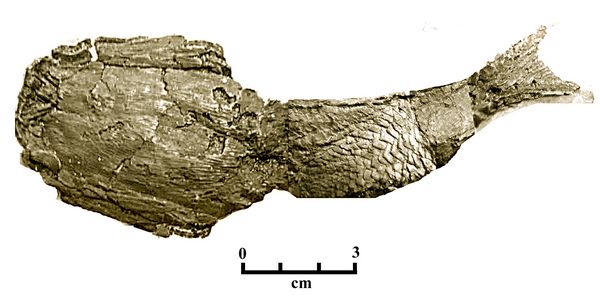 Fig.2: Arandaspis priontoleps, an Early Ordovician jawless fish from Australia (after Ritchie and Gilbert-Tomlinson 1977 ).
Fig.2: Arandaspis priontoleps, an Early Ordovician jawless fish from Australia (after Ritchie and Gilbert-Tomlinson 1977 ).Arandaspis was about 15 cm (6 in) long, with a streamlined body covered in rows of knobbly armoured scutes. The front of the body and the head were protected by hard plates with openings for the eyes, nostrils and gills. Although it had no jaws, Arandaspis might have had some moveable plates in its mouth, serving as lips, sucking in food particles. The low position of its mouth suggests Arandaspis foraged the ocean floor. It had no fins; its only method of propulsion was its horizontally flattened tail. As a result, it probably swam in a fashion similar to a modern tadpole (Janvier 1998; White 2008).
Arandaspida also includes the South American genus Sacabambaspis, whose type species was found in Bolivia in a group of over 30 fossil specimens in a small area, probably caught in a mudslide or large storm (Gagnier et al. 1986). Other species have been found in Argentina, Oman, and Australia, showing a global distribution around the Ordovician land mass of Gondwanaland.
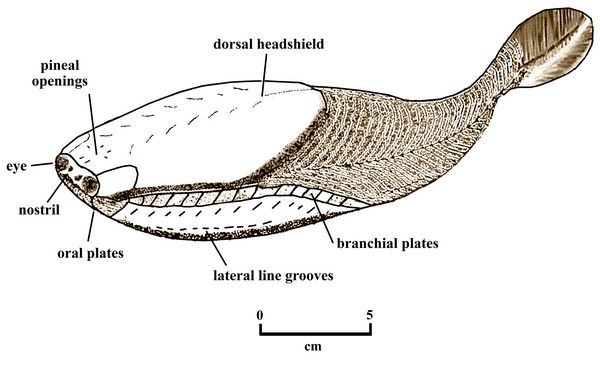 Fig.3: Sacabambaspis janvieri, an Ordovician jawless fish from Sacabamba in Bolivia (after Gagnier et al. 1986).
Fig.3: Sacabambaspis janvieri, an Ordovician jawless fish from Sacabamba in Bolivia (after Gagnier et al. 1986).Sacabambaspis (fig.3) had a head shield made from a large upper or dorsal plate that rose to a slight ridge in the midline, and a deep curved lower or ventral plate. Linking these along the sides were narrow branchial plates which covered the gill area. The rest of body was covered by long, strap-like scales behind the head shield.The tail consists of relatively large dorsal and ventral webs and an elongated notochordal lobe, a tail structure quite different from that of the Heterostracians (Pradel et al. 2013).
Sacabambaspis is also characterized by large, frontally positioned eyes. Between them are traces of two small nostrils, and a mouth armed with about 60 thin oral plates, whose function remains unclear. Like other Pteraspidans, Sacabambaspis had a lateral line system for sensing movements in the water, such as from predators (Gagnier et al. 1986).
Astrapida.
Astrapida (“star-shields”) include the armored species Astraspis desiderata (fig.4) from the Ordovician at ca. 450 mya. Examples have been found in Colorado (Sanson et al. 1997) as well as Bolivia (Gagnier 1993) . The Colorado
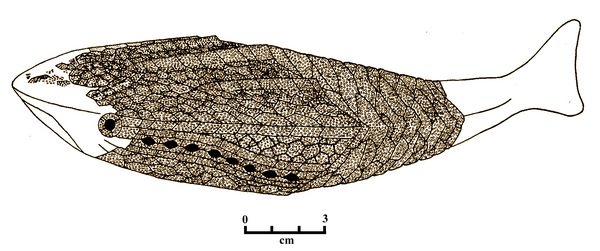 specimen
had relatively large eyes flanked by a series of eight gill openings on
each side. The protective bony plates were composed of aspidin (similar
to that in modern shark's teeth), covered by tubercles composed of
dentine. The genus is named for these tubercles, which are generally
star-shaped.
specimen
had relatively large eyes flanked by a series of eight gill openings on
each side. The protective bony plates were composed of aspidin (similar
to that in modern shark's teeth), covered by tubercles composed of
dentine. The genus is named for these tubercles, which are generally
star-shaped. Fig.4: Astraspis desiderata, an Ordovician jawless fish found in Colorado (after Sanson et al. 1997).
While no complete fossils of Astrapids have yet been found, adult forms are estimated to have been about 20 cm (8 in.) long. They had a mobile tail covered with small protective scales less than1 mm long, and a head region covered with larger scales, greater than 2 mm in length. Like Sacabambaspis, Astraspis shows clear evidence of having a lateral line sensory system, ennabling the fish to detect the direction and distance of movements in the water.
Heterostraci.
Heterostraci ("different scales"), the third subclass of Pteraspida, lived in both marine and estuarine environments. The Heterostracans arose during the Ordovician period (495-445 mya), and lasted into the late Devonian period (380-370 mya), when all taxa, except the family called Psammosteids, became extinct. The scales of heterostracans are distinct from those of other vertebrates, having three layers composed of dentine and aspidin, the latter being a cellular bony tissue unique to this class. The middle layer of the scales was honeycombed with tiny spaces called cancella.
The Heterostracans also differed from other Paleozoic agnathan classes in the arrangement of their scales. Most heterostracans had two plates which form a large dorsal shield and a large ventral shield, and had series of scales arranged in various patterns on the sides of their bodies, the exact pattern differing from one group to another. In a few primitive forms, such as the genus Lepidaspis, the dorsal and ventral shields are composed of a mosaic of tiny scales. In most other known forms, however, these tiny scales have fused together to form the shield-plates typical of the Pteraspida.
As with many agnathan groups, heterostracans had no fins besides those of the tail (the caudal fin). In some pteraspids, especially in the psammosteids, the ends of the branchial plates which covered the gills were drawn out to form wing-like extensions.
The Heterostraca subclass contains two orders, Pteraspidiformes ("wing shields"), and Cyathaspidiformes (“cup shields”). Members of the larger, “wing-shield” order first occurred in the Late Silurian, but become much more diverse during the Early Devonian. They include both streamlined, spiny forms like Pteraspis (fig.6) and Doryaspis (fig.5), and flattened bottom-dwellers, some of which grew to large size. All Pteraspidiformes have a dorsal shield made up of several independent plates. In this they contrast with the Cyathaspidiformes, whose body plates tended to fuse into a single unit.
Pteraspidiformes (the "wing shield" order).
The Pteraspidiformes are divided into five families, including the more primitive Anchipteraspididae, the telated Protopteraspididae and Pteraspididae, the Protaspididae, and the Psammosteidae. The Anchipteraspididae (including the genera Anchipteraspis, Ulutitaspis,and Rhachiaspis) are small primitive forms from the Late Silurian and Early Devonian of the Canadian Arctic. They are close to the ancestral stock from which other pteraspidiforms evolved.
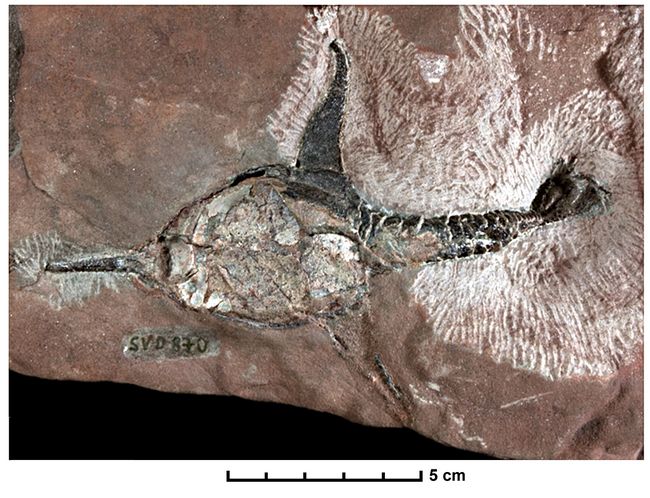 Protopteraspididae ("proto-wing shields")
are morphologically quite similar to their successors the Pteraspididae. Some protopteraspidids, however, such as
Doryaspis ("golden shield"), are distinguished by a sawfish-like snout or rostrum. Doryaspis (fig.5) lived during the Early Devonian in
northern Euroamerica. Bony spines were set along the length of its
rostrum, but unlike modern sawfish, the mouth of Doryaspis is situated
above, rather than below, the rostrum. The purpose of this
appendage is not clear. It may have been used to stir up
the mud or sand at the ocean bottom, in order to find crustacea or
other tiny invertebrates. Doryaspis, 15 cm in length, also had
unusually long, lateral keels growing from the back of the head shield.
The forward edges of these appendages were also armed with tooth-like
spines.
Protopteraspididae ("proto-wing shields")
are morphologically quite similar to their successors the Pteraspididae. Some protopteraspidids, however, such as
Doryaspis ("golden shield"), are distinguished by a sawfish-like snout or rostrum. Doryaspis (fig.5) lived during the Early Devonian in
northern Euroamerica. Bony spines were set along the length of its
rostrum, but unlike modern sawfish, the mouth of Doryaspis is situated
above, rather than below, the rostrum. The purpose of this
appendage is not clear. It may have been used to stir up
the mud or sand at the ocean bottom, in order to find crustacea or
other tiny invertebrates. Doryaspis, 15 cm in length, also had
unusually long, lateral keels growing from the back of the head shield.
The forward edges of these appendages were also armed with tooth-like
spines.Fig.5: Dorypaspis fossil (French Museum of Natural History).
The Pteraspididae ("winged shields") probably evolved from the Protopteraspididae. Like the latter, they were streamlined swimmers.
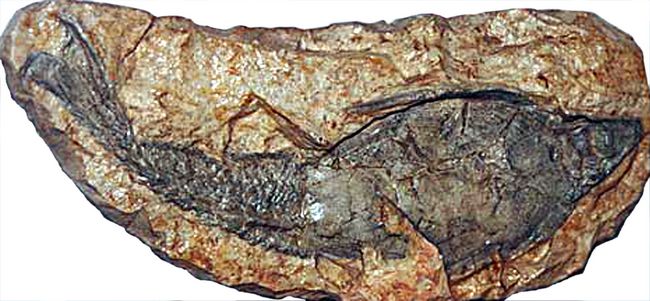 Pteraspis, the type genus and the most representative member of the
family, was about 20 cm long, with a rostrum of more normal
proportions (fig.6). The rostrum may have
served a dual purpose, both hydrodynamic while swimming, and used to
probe the mud and sediment for small organisms. Significantly,
the existence of an elongated rostral spine, and sometimes side spines
or wings or cornua as well, seems to have been a recurring theme among
the early Devonian ostracoderms.
Pteraspis, the type genus and the most representative member of the
family, was about 20 cm long, with a rostrum of more normal
proportions (fig.6). The rostrum may have
served a dual purpose, both hydrodynamic while swimming, and used to
probe the mud and sediment for small organisms. Significantly,
the existence of an elongated rostral spine, and sometimes side spines
or wings or cornua as well, seems to have been a recurring theme among
the early Devonian ostracoderms.Fig.6: Pteraspis fossil (American Museum of Natural History)
The Pteraspids became very numerous and diverse during the Late Silurian and Early Devonian periods (ca.420-390 mya). Although lacking paired fins, the pteraspids were probably powerful swimmers. Stability was provided by the wing-like outgrowths from the back of the head shield. A large spine over the back acted as a kind of dorsal fin, while 2 rigid 'wings' or keels functioned as pectoral hydrofoils (Janvier 1997). The long, flexible tail was also hydrodynamic, with the lower lobe elongated to provide lift at the front of the body during swimming. Additional lift was provided by the elongated snout, which was drawn out into a bladelike 'rostrum', below which the mouth opened. It is thought that the pteraspids and protopteraspids fed in mid-water or near the surface of the sea, among the shoals of planktonic, shrimp- like crustaceans.
The Protaspididae ("proto-shields") are early Devonian transitional forms between the Pteraspididae and Pammosteida. The head shield has already become broad and flattened, indicating a shift to a benthic (bottom-living) existence. The Pammosteida are the youngest and largest members of the
 “wing-shield” order. These meter-long, meter-wide fish died out
in the major extinction event at the end of the Devonian (359 mya).
Among the possible ancestors of the latter was the genus
Drepanaspis (fig.7), a frying-pan shaped fish whose fossils have been
found in the fine-grained Devonian shales in the Rhineland at Hunsrück,
Germany. It was a flattened creature with a heavily armored body,
somewhat ray-like in appearance. Drepanaspis had small, widely spaced
eyes. Its mouth faced upwards, unlike most other Heterostracans,
which had downward-facing mouths. It is presumed to have foraged the ocean floor for food.
“wing-shield” order. These meter-long, meter-wide fish died out
in the major extinction event at the end of the Devonian (359 mya).
Among the possible ancestors of the latter was the genus
Drepanaspis (fig.7), a frying-pan shaped fish whose fossils have been
found in the fine-grained Devonian shales in the Rhineland at Hunsrück,
Germany. It was a flattened creature with a heavily armored body,
somewhat ray-like in appearance. Drepanaspis had small, widely spaced
eyes. Its mouth faced upwards, unlike most other Heterostracans,
which had downward-facing mouths. It is presumed to have foraged the ocean floor for food.Fig.7: Drepanaspis gemuendensis, whose fossil was found in Devonian deposits along the Rhine River (after Elliot and Mark-Kurik 2005).
Cyathaspidiformes.
Cyathaspidiformes are divided into two suborders, the Amphiaspida of Early Devonian Siberia (grouped together with their relative Ctenaspis of Canada), and the Cyathaspidida (grouped together with their relative Nahanbiaspis.
Anaspids.
The Anaspida (“no shield”) comprise another class of jawless fish who lived from the Early Silurian through Devonian periods (445-359 mya). All typical anaspids are Silurian in age. Anaspids are classically regarded as close relatives or ancestors of lampreys. Current analyses, however, show anaspids mixed in with a heterogenous grouping of fish classes, largely due to the lack of information about their internal anatomy (Janvier 1997).
Anaspids have a laterally compressed body, a large dorsal web and a notochordal lobe in the caudal fin, and an anal fin. They clearly possess thin, sometimes ribbon-shaped paired fins, but it is uncertain whether these contained musculature and radials. The body is covered with rod-shaped scales arranged in chevrons, and the head is covered with minute scales and platelets forming the skull-roof. The gill opnings (8 to 15 in number) are minute and aligned in slanting row behind the eye.
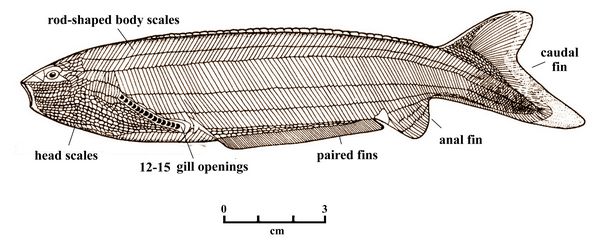
The most generalized anaspids are exemplified by Pharyngolepis ("throat scale") from the Late Silurian in the Baltic area of Norway. Pharyngolepis (fig.8) had well-developed caudal and anal fins, but no paired or dorsal fins that would have helped stabilize it in the water. Thus, it was probably a poor swimmer, remaining close to the sea bottom, where it could scoop up food from the ocean floor. The usual pectoral fins on fish were instead replaced by bony spines on Pharyngolepis, possibly for protection against predators, and there was a row of spines along its back.
Fig.8: The Late Silurian Pharyngolepis, from the Baltic region (after Norsk Geologisk Forening).
Theolodonts.
Thelodonts ("nipple teeth") are a class of aganthans which first appeared during the Late Ordovician (450 mya), and lived until the Frasnian–Famennian extinction at the end of the Devonian (about 359 mya). Unlike many other aganthan fishes during the Ordovician and Silurian periods, Thelodonts were not covered with large plates of protective dermal armor. Instead, by the Late Ordovician, these agnathan fish had developed more flexible body
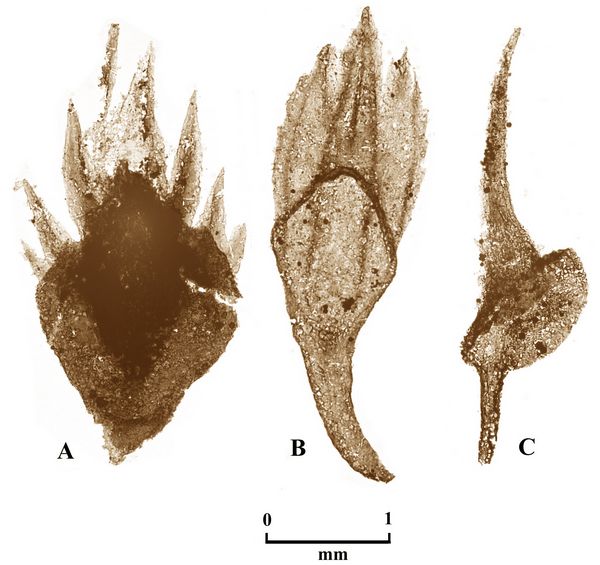 armor
in the form of scales. The thelodont exoskeleton was composed of
many tooth-like or spiny scales called denticles, 0.5-1.5 mm wide
(fig.9). They also had a full complement of lateral, dorsal, and
anal fins, plus fork-shaped tails that became typical for many jawed
fish. These appendages (forerunners to tetrapod limbs) improved chances
of escaping predation as well as catching prey. These, and the variety
of the armored Theolodont scales, show major adaptations during the
Late Ordovician and Silurian periods, related to defences from
predators such as the giant sea scorpion (fig.12).
armor
in the form of scales. The thelodont exoskeleton was composed of
many tooth-like or spiny scales called denticles, 0.5-1.5 mm wide
(fig.9). They also had a full complement of lateral, dorsal, and
anal fins, plus fork-shaped tails that became typical for many jawed
fish. These appendages (forerunners to tetrapod limbs) improved chances
of escaping predation as well as catching prey. These, and the variety
of the armored Theolodont scales, show major adaptations during the
Late Ordovician and Silurian periods, related to defences from
predators such as the giant sea scorpion (fig.12).Fig.9: Theolodont scales, from A) Paralogonia sp.; B) Shielia taiti; C) Lanarkia horrida (after Turner 1991).
Thelodont fossil specimens described in 1993 were the first to be found with a significant degree of three-dimensionality. Unexpectedly, these fossils revealed that these agnathians had stomachs; previously it had been thought that stomachs evolved after jaws. Distinctive fork-shaped tails, usually characteristic of the jawed fish (gnathostomes), were also found, further linking jawless and jawed fish to an unexpected degree.
Thelodonts were morphologically very similar, and probably closely related, to fish of the classes Heterostraci and Anaspida, differing mainly in their distinctive scales. The four orders of Theolodonts included Theleodontina, Loganiida, Katoporida, and Furcacaudiformes, comprising a total of 67 species.
Thelodontina lived in both freshwater and marine environments. They were predominantly bottom dwellers, although there is evidence that some species were also free-swimmers. They had paired pectoral fins combined with single, well-developed, dorsal and anal fins, a substantial innovation over the early Ordovician agnathians who had only tail fins. Thelodont fins resemble those of modern fish associated with both agile predation, and evasion.
Loganellia, type genus of the order Loganiida, lived from the Late Ordovocian to the Late Silurian. Well-preserved fossils of Loganellia (fig.10) have been found at the Early Silurian site of Lesmaghow in Scotland, clearly showing the paired pectoral fins, and single dorsal and anal fins.
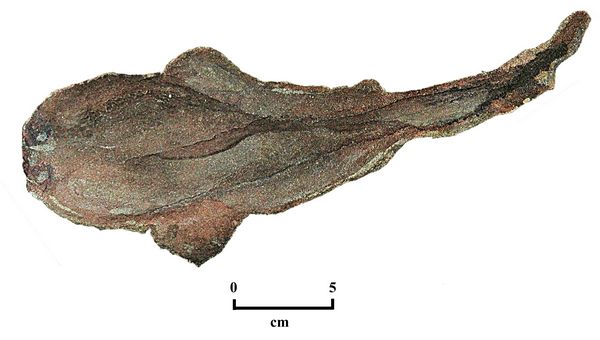
As in the case of most other Theolodonts, the scales of Loganellia are considered species-diagnostic . The teardrop-shaped thelodont scales are mounted on a base, often with a small rootlet that attached the scale to the fish. These non-overlapping scales were aligned to point backwards along the fish, in a streamlined direction. Readily dispersed after death, the Thelodont scales are the most commonly found vertebrate fossil of their period.
Fig.10: The Theolodont Loganellia, found in Scotland.
Often the scale has linear ridges and spikes along its length, showing sometimes complex patterns, which together with the overall form of the scale are useful for identification. The scales are not necessarily a result of shared ancestry, however, but may have evolved independently by different groups. Thus the thelodonts may represent a polyphyletic or mixed-ancestry group, something much debated.
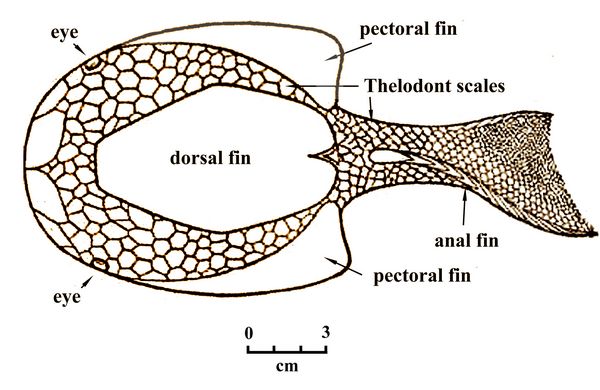 From
the Late Silurian site of Traquair in Scotland came well-preserved
examples of the genus Lanarkia (fig.11), in the Katoporida subclass of
Thelodonts. These comprised two species, Lanarkia horrida and L.
spinosa. Their thin, spiky scales (fig.9C) show a potential for giving
distinct discomfort to any unwary predator. Given the presence,
however, of large sea scorpions (euryptids) up to 2 meters long, such
as Pterygotus (fig.12), the main predator of the Silurian seas, the
Lanarkia needed all the protection that armored scales plus enhanced swimming abilities
could provide.
From
the Late Silurian site of Traquair in Scotland came well-preserved
examples of the genus Lanarkia (fig.11), in the Katoporida subclass of
Thelodonts. These comprised two species, Lanarkia horrida and L.
spinosa. Their thin, spiky scales (fig.9C) show a potential for giving
distinct discomfort to any unwary predator. Given the presence,
however, of large sea scorpions (euryptids) up to 2 meters long, such
as Pterygotus (fig.12), the main predator of the Silurian seas, the
Lanarkia needed all the protection that armored scales plus enhanced swimming abilities
could provide.Fig.11: The Late Silurian Lanarkia, found in Scotland.
Cephalaspids.
Cephalaspids (“head-shields”) are a class of armored, jawless fish who lived in the Silu
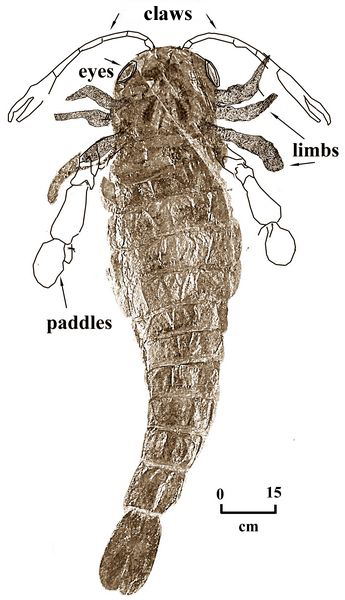 rian
and Devonian periods (428-359 mya). Cephalaspis is the type genus this
group, which contains a wide array of forms, including the large
Parameteoraspis, with a headshield up to 45 cm wide. Their
well-developed head shields served to protect the head, gills and
anterior internal organs. The head shield had a series of grooves over
its surface which formed an extensive lateral line organ, while their
small eyes were located on top of their heads. Outside
of the head shield, no internal or axial skeleton is known; it probably
consisted of an unsegmented notochord made of cartilage.
rian
and Devonian periods (428-359 mya). Cephalaspis is the type genus this
group, which contains a wide array of forms, including the large
Parameteoraspis, with a headshield up to 45 cm wide. Their
well-developed head shields served to protect the head, gills and
anterior internal organs. The head shield had a series of grooves over
its surface which formed an extensive lateral line organ, while their
small eyes were located on top of their heads. Outside
of the head shield, no internal or axial skeleton is known; it probably
consisted of an unsegmented notochord made of cartilage.The Cephalaspids were probably bottom-feeders, who likely spent much of their time semi-submerged in the mud. They would have been algae- or filter feeders, combing the bottom for small animals. In lieu of a jaw, the mouth opening of the Cephalaspids was surrounded by small plates making the mouth flexible, but with no ability to bite.The tail had a single, wrap-around tail-fin; modern fishes with such a tail are rarely quick swimmers, or predators. A fleshy appendage which emerged on each side behind the head shield served as pectoral fins. The Cephalaspids also lacked a swim bladder, and would not have been able to keep afloat without actively swimming.
Fig.12: The giant sea scorpion Pterygotus, a top predator of jawless fishes.
The Cephalaspids were first fully described in the 1920s by two Scandanavian researchers, Johan Kiær of the University of Oslo, and Erik Stensiö (1927) of the Swedish National Museum. Both identified the class as a grouping of osteostracans, anaspids, and lampreys, because all three groups share a single dorsal nasal opening. Due to ossification of the endoskeletal headshield, the internal anatomy of osteostracans could be studied in detail. Given this intensive study, the cephalaspids have played an important role in the history of vertebrate palaeontology, prompting many debates about the organization of the primitive vertebrate head.
Osteostraci.
The Osteostraci (“bone shields”) include about 200 species which lived from the Early Silurian to the Late Devonian (ca. 430-370 mya). The bodies of osteostracans were covered with large, diamond-shaped scales. Sizes ranged from 1 m to 4 cm., with most osteostracans about 20 to 40 cm in length. Most have a characteristic horseshoe-shaped skull, covered with a shield of dermal bone.
On the dorsal or top surface of the head are closely-set eyes, a pineal foramen, and a keyhole-shaped nasohypophysial opening. An example is the small-sized Mimetaspis conco
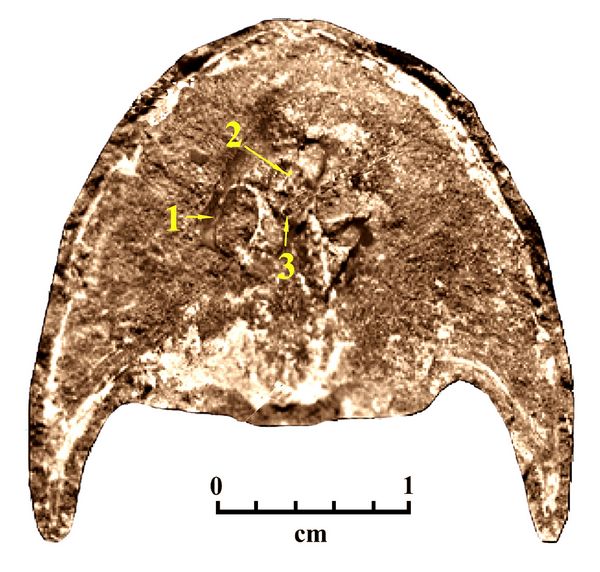 rdis,
found in an Early Devonian strata exposed along the Dneister River in
the Ukraine (fig.13.) In addition, there are peculiar depressions of
the braincase, covered with loose platelets of dermal bone, regarded as
either sense organs or electric organs. Some species also have hornlike
processes protruding from the head shield. The mouth and gill openings
are, as in the Galeaspida, on the lower or ventral side of the head.
Osteostracans also have two large, pad-shaped dorsal fins (reduced to
one or none in the more advanced forms). These dorsal fins contained
muscles, and were attached to the the headshield (Janvier 1997).
rdis,
found in an Early Devonian strata exposed along the Dneister River in
the Ukraine (fig.13.) In addition, there are peculiar depressions of
the braincase, covered with loose platelets of dermal bone, regarded as
either sense organs or electric organs. Some species also have hornlike
processes protruding from the head shield. The mouth and gill openings
are, as in the Galeaspida, on the lower or ventral side of the head.
Osteostracans also have two large, pad-shaped dorsal fins (reduced to
one or none in the more advanced forms). These dorsal fins contained
muscles, and were attached to the the headshield (Janvier 1997).Fig. 13: The headshield of Mimetaspis, an small Early Devonian Cephalaspid from the Ukraine. 1) eye orbit. 2) “nostril.” 3) pineal opening (after Voistechin 2011).
Most osteostracans lived in marginal, marine environments. Their horseshoe-shaped headshield suggests a benthic or bottom-feeding mode of life. They are most diverse in the Early Devonian, becoming rare in the Middle and Late Devonian. Osteostracans are widely distributed in North America, Europe, Siberia, and Central Asia. Subclasses include the Zenaspidida, Benneviaspidida, Kiearaspidida, and Thyestiida.
The Zenaspidida have a more massive headshield, often bearing a posterior median crest or spinal process. They have a characteristic ornamentation of large tubercles, surrounded by smaller ones (fig.14B).
The Benneviaspidida have a flattened headshield and their exoskeleton has lost the polygonal pattern of the platelets, to form a continuous layer. Some benneviaspidids, such as the Boreaspididae, develop a long rostral process, like some galeaspids and pituriaspids. One of them, Tauraspis, is unique in having a pair of forward pointing "horns" (fig.14C).
The Kiearaspidida are small osteostracans whose headshield extends posteriorly into a long abdominal
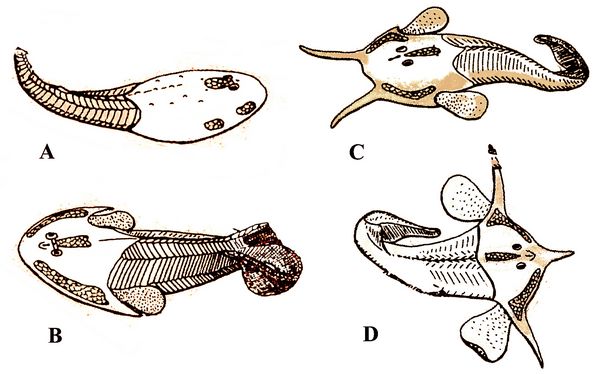 division
and whose cornual processes are extremely reduced or lost. Some of
them, the Acrotomaspididae, are very specialized forms, with extremely
reduced cephalic fields and their mouth opens anterodorsally.
division
and whose cornual processes are extremely reduced or lost. Some of
them, the Acrotomaspididae, are very specialized forms, with extremely
reduced cephalic fields and their mouth opens anterodorsally.Fig. 14: Osteostracans from the clade Cornuata. A) The thyestid Tremataspis, who lacks paired fins, perhaps due to specialized burrowing habits. B) the zenaspidid Zenaspis, a typical form with a massive headshield. C. the benneviaspidid Tauraspis, with double head shield projections. D) the benneviaspidid Hoelaspis, with triple headshield projections (after Janvier 1997).
The Thyestiida are also small osteostracans, characterized by the special structure of their sensory-line canals. They include forms, the Tremataspididae, which have lost the paired fins and cornual process, their headshield becoming olive-shaped (fig.14A). This may represent an adaptation to burrowing habits.
References:
Adrain, J. M. and M.V.H. Wilson 1994. "Early Devonian cephalaspids (Vertebrata: Osteostraci: Cornuata) from the southern Mackenzie Mountains, N.W.T., Canada." Journal of Vertebrate Paleontology, 14, pp. 301-319. [Osteostraci]
Afanassieva, O. 1991. The cephalaspids of the Soviet Union. Trudy Paleontologicheskogo Instituta Akademia Nauk, 248, Moscow. [Osteostraci]
Arsenault, M. and P. Janvier 1991. "The anaspid-like craniates of the Escuminac Formation (Upper Devonian) from Miguasha (Québec, Canada), with remarks on anaspid-petromyzontid relationships." In Early vertebrates and related problems of evolutionary biology (ed. M. M.Chang, Y. H. Liu, and G. R. Zhang) Science Press, Beijing, pp. 19-40. [Anaspids]
Benton, M. J. 2005. Vertebrate Palaeontology (3rd Ed.). Blackwell Publishing.
Forey, P. and P. Janvier, Philippe 2012. "Agnathans and the origin of jawed vertebrates". In Gee, Henry. Shaking the tree: readings from Nature in the history of life. USA: University of Chicago Press; Nature/Macmillan Magazines. pp. 251–266. [Cephalaspids]
Gagnier, P-Y 1993. [Pteraspida]
Gagnier, P-Y, A. Blieck and Rodrigo 1986. "First Ordovician vertebrate from South America." Geobios (Villeurbanne), 19(5) pp. 629-634. [Pteraspida; Arandaspida]
Janvier, P. 1984. "The relationships of the Osteostraci and Galeaspida." Journal of Vertebrate Paleontology, 4, pp. 344-358. [Osteostraci]
Janvier, P. 1997. "Arandaspida". The Tree of Life Web Project. [Pteraspida; Arandaspida]
Janvier, P. 1998. Early vertebrates. Oxford, New York: Oxford Univ. Press, 1998. [Anaspids; Cephalospidomorhi; Osteostraci]
Janvier, P. 2008. "Early Jawless Vertebrates and Cyclostome Origins". Zoological Science 25 (10), pp. 1045–1056. [Cephalaspids].
Kiaer, J. 1924. The Downtonian fauna of Norway. 1. Anaspida. Skrifter utgitt af det Norske Videnskapsakademien, 1, matematisk-naturvidenskapslige Klasse, 6, pp. 1-139. [Anaspids]
Mark-Kurik, E. and P. Janvier 1995. "Early Devonian osteostracans from Severnaya Zemlya, Russia." Journal of Vertebrate Paleontology. 15(3), pp. 449-462. [Osteostraci]
Nelson, Joseph S. 2006. Fishes of the World (4th ed.). John Wiley and Sons. [Cephalaspids]
Norsk Geologisk Forening - "Landet blir til - Norges geologi" [Anaspids]
Parrington, F. R. 1958. "On the nature of the Anaspida." In: Studies on fossil vertebrates (ed. T. S. Westoll), pp.108-128, The Athlone Press, London. [Anaspids]
Pradel, A., I. J. Sansom, P-Y Gagnier, R. Cespedes, and P. Janvier 2013. "The tail of the Ordovician fish Sacabambaspis". Biology Letters, p. 47. [Pteraspida; Arandaspida]
Ritchie, A. 1964. "New light on the morphology of the Norwegian Anaspida." Skrifter utgitt av det Norske Videnskaps-Akademi, 1, Matematisk-Naturvidenskapslige Klasse, 14, pp. 1-35. [Anaspids]
Ritchie, A. 1967 . "Ateleaspis tessellata Traquair, a non-cornuate cephalaspid from the Upper Silurian of Scotland." Zoological Journal of the Linnean Society, 47, pp. 69-81. [Osteostraci]
Ritchie, A. 1968. "New evidence on Jamoytius kerwoodi White, an important ostracoderm from the Silurian of Lanarkshire, Scotland." Palaeontology, 11, pp. 21-39. [Anaspids; Osteostraci]
Ritchie, A. 1980. "The Late Silurian anaspid genus Rhyncholepis from Oesel, Estonia, and Ringerike, Norway." American Museum Novitates, 2699, pp.1-18. [Anaspids]
Ritchie, A. and Gilbert-Tomlinson 1977. [Pteraspida; Arandaspida]
Sansom I.J., M.P. Smith, M.M. Smith, and P. Turner 1997. "Astraspis: The anatomy and histology of an Ordovician fish." Palaeontology, 40 (3), pp. 625–642. [Pteraspida; Astrapida]
Stensiö, E. A. 1927. "The Devonian and Downtonian vertebrates of Spitsbergen. 1. Family Cephalaspidae." Skrifer om Svalbard og Ishavet, no. 12, pp. 1-391. [Cephalaspids; Osteostraci]
Stensiö, E.A. 1964. "Les Cyclostomes fossiles ou Ostracodermes." In: Traité de paléontologie (ed. J. Piveteau), Vol. 4(1), pp. 96-383, Masson, Paris. [Anaspids; Osteostraci]
Turner, S. 1991. "Monophyly and interrelationships of the Thelodonti." In Early vertebrates and related problems of evolutionary biology (ed. M. M. Chang, Y. H. Liu, and G. R. Zhang), pp. 87-111. [Theolodonts]
Voistechin 2011 [Cephalaspids, Osteostraci]
Wängsjö, G. 1952. "The Downtonian and Devonian vertebrates of Spitsbergen. 9. Morphologic and systematic studies of the Spitsbergen cephalaspids." Results of Th. Vogt's Expedition 1928 and the English-Norwegian-Swedish Expedition in 1939. Norsk Polarinstitutt Skrifter, 97, 1-611. [Osteostraci]
Watson, D. M. S. 1954. "A consideration of ostracoderms." Proceedings of the Royal Society of London, B, 238, pp.1-25. [Osteostraci]
White, A. 2009. "Thelodonti: Cephalaspidomorphi". www.Palaeos.org website. [Cephalaspids]
White, E. I. 1946. "Jamoytius kerwoodi, a new chordate from the Silurian of Lanarkshire." Geological Magazine, 83, pp. 89-97. [Anaspids]
White, E. I. and H.A. Toombs 1983. "The cephalaspids from the Dittonian at Cwm Mill, near Abergavenny, Gwent." Bulletin of the British Museum (Natural History), Geology, 37, 149-171. [Cephalaspids, Osteostraci]
Whiting, H. P. 1977. "Cranial nerves in lampreys and cephalaspids." In Problems in Vertebrate Evolution, Linnean Society Symposium Series, No. 4, (ed. S.M. Andrews, R. S. Miles, and A.D. Walker), pp. 1-23. Academic Press, London. [Osteostraci]
Young 1997 [Pteraspida; Arandaspida]
Glossary